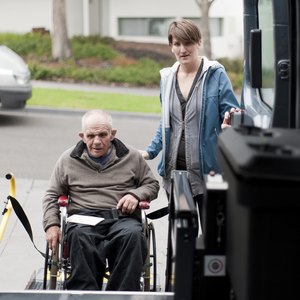
You might be called elderly if you are older than 60, by some definitions, and your physical abilities might start limiting your freedom to go where you want to go when you want to go there. For instance, according to a 2011 report by statisticians at Caregivers Library, there are 8.4 million seniors in the United States who depend on other people for transportation. Many transportation problems can be solved with common sense solutions.
Driving Problems
Cars and roadways are built for the average driver's reflexes, agility and vision. But, as pointed out by Caregivers Library, aging drivers eventually lose the ability to use these transportation systems as they are designed. The size of sign wordage, distance from warnings to hazards, size and brightness of lighted signals and many other features make roads less accommodating to elderly drivers.
Distance To Public Transportation
Studies published in the "Japanese Journal of Gerontology" document the ongoing problem for elderly non-drivers of walking distance to public transportation systems. Bus routes to elder care facilities might help, but, especially in rural areas where public transportation might be inaccessible, isolation also can limit access to taxis or other services for transportation.
Inadequate Ingress
Public transportation, for instance buses and trains, might require an inconveniently high step for entry. "Kneeling" buses or extendible steps can help. Transportation stations also can present turnstile obstacles.
Timing
Subway cars usually are at platform levels but the duration of door opening might be too brief for slow walkers. If an elderly person chooses to walk, traffic signal timing might present a problem if a green light is too brief to permit safe crossing, as documented in the Japanese studies.
Steps Vs. Ramps
Most municipalities require wheelchair ramp access to street crossings, public buildings and public transportation stations. But old construction, which limits ramp space, and budget constraints make this solution less than universal.
Scheduling
The Japanese researchers detected significant differences between the hours elderly people want transportation and the hours mass transport might be most available. To avoid heavy sidewalk traffic, for instance when going to and from bus stations, many elderly avoid rush hours, but public systems often decrease service during off hours.
Geography and Poverty
Inability to drive, the most common elderly transportation problem, makes geography problematic. In the absence of door-to-door assistance by other drivers, elderly people might be stopped even by low hills that are irrelevant to younger people. Urban and rural isolation and inability to pay for multiple modes of transportation can make the elderly into virtual prisoners in their homes.
Fragmented Services
In a report to Congress presented by the U.S. Government Accounting Service, a special problem for elderly travelers is identified as fragmentation or dis-coordination among transportation services. Failure to coordinate pickup and drop-off routes and schedules, travel fares, accessibility barriers and other issues continue to be problems.
Burden To Others
The Japanese gerontology researchers identified one transportation problem as self-imposed: Many elderly people, realizing that their need for help increases over time, resist becoming a burden to family and friends. Strong family support, churches and civic groups are identified as potential solutions.
Family Conflict
While daily travel by the elderly might decrease with age, it also might increase with greater medical care travel needs. Simultaneously, transportation needs of their children's growing families and complex schedules might increase over time. Family might become unable, unwilling or impatient with the transportation problems of their elderly members.
References
- Japanese Journal Of Geriatrics: Transportation Problems and Social Activities of Elderly People
- Japanese Journal Of Geriatrics: Perceived Transportation Problems of Elderly People
- GAO: Services for the Elderly: Longstanding Transportation Problems Need More Federal Attention
- Caregivers Library: Issues Facing Older Adults Who May be Losing Their Ability to Drive
Writer Bio
Walt Pickut has published peer-reviewed medical research since 1971. Pickut teaches presentational speaking and holds board registries in respiratory care and sleep technology. He is a member of the Society of Professional Journalists and the American Society of Business Publication Editors and is editor for "The Jamestown Gazette." Pickut holds bachelor's degrees in biology and communication, and master's degrees in physiology and mass communication.

